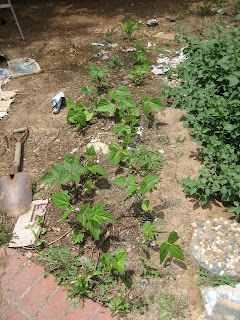 Since the sunberries are winding down I've started ten new tomato plants to replace them with, most of them Red Siberians to carry us through the cold-ish months. I'm curious to see if they'll make it straight through the winter. I'm hoping for a bumper crop from these babies, for canning. My other canning tomatoes have not done so well and now the japanese beetles are moving in and eating them:(. Quick side note, my plan for the japanese beetles this year was to just pick them off of the plants in the early mornings when they are sluggish, but they have outsmarted me again! They are living in our neighbor's yard and coming over into our yard in the afternoons for feeding time. Very frustrating!
Since the sunberries are winding down I've started ten new tomato plants to replace them with, most of them Red Siberians to carry us through the cold-ish months. I'm curious to see if they'll make it straight through the winter. I'm hoping for a bumper crop from these babies, for canning. My other canning tomatoes have not done so well and now the japanese beetles are moving in and eating them:(. Quick side note, my plan for the japanese beetles this year was to just pick them off of the plants in the early mornings when they are sluggish, but they have outsmarted me again! They are living in our neighbor's yard and coming over into our yard in the afternoons for feeding time. Very frustrating!We are also replacing our first rotation of bush beans. Bush beans generally only produce beans for a two week period before dying back, so it's good to plant several rows of them with sowing dates a week or two apart, to keep you in constant supply. We have four rows of bush beans, or to be honest, two rows and two self watering containers, each with an equal number of plants. The good news about bush beans (and really any legume) is that they have the uncanny ability to pull nitrogen from the air and fix it into the soil through their roots. This makes bush beans an ideal crop to plant near hungrier crops like squash, melons, corn, tomatoes, etc. Once the plant has died all of the extra nitrogen remains in the soil, so bush beans are an ideal candidate to be replaced by hungrier crops as well. In our case I am replacing the first bush bean row with hard winter squashes. Instead of pulling out the tired green bean plants it is a good idea to snip them off as close to the ground as possible. Leaving their roots in the ground means you are leaving as much nitrogen in the ground as possible. After snipping the green bean plants I laid them on top of the soil along with some dead tomato plants and other trimmings, then I spread a bag of manure over the whole thing creating a small grow heap. I also added plenty of organic fertilizer.
And lastly the determinate, silvery fir tree tomatoes, which were in five gallon buckets, have been replaced by basil.
Things are looking good in our garden, despite my sister's boyfriend commenting "if people didn't know what you were doing back here they'd think there was just trash everywhere." Lovely. :) He is referring to the fact that I use junk mail to mulch the walkways between rows and keep the weeds down. Here are some pictures for your viewing delight:)
 A funny italian zucchini I found today. It looks like it was going to have a siamese twin but things didn't quite work out. Am I the only one who saw this and thought: Alien fetus? That's just me? Ok then, moving on...
A funny italian zucchini I found today. It looks like it was going to have a siamese twin but things didn't quite work out. Am I the only one who saw this and thought: Alien fetus? That's just me? Ok then, moving on... Today's summer squash harvest.
Today's summer squash harvest.  One of the self-waterers with new green bean plants. Side note, the self waterer book I ordered from the library is in, I'm picking it up today and hope to have lots of juicy tips for you all.
One of the self-waterers with new green bean plants. Side note, the self waterer book I ordered from the library is in, I'm picking it up today and hope to have lots of juicy tips for you all.  The Cayenne Peppers are turning red, we'll have hot sauce in no time, hooray!
The Cayenne Peppers are turning red, we'll have hot sauce in no time, hooray!  Our Myrtle is in bloom three months late. What is that about? I've heard that myrtle is sometimes eaten as an herb. I'm still a little too skeptical to try.
Our Myrtle is in bloom three months late. What is that about? I've heard that myrtle is sometimes eaten as an herb. I'm still a little too skeptical to try. A new zucchini plant on the rise!
A new zucchini plant on the rise! One of our hot pepper plants called Tequila Sunrise. It grows very similar to the tabasco pepper. I'm really hoping it tastes similar. I loves me some tabasco sauce!
One of our hot pepper plants called Tequila Sunrise. It grows very similar to the tabasco pepper. I'm really hoping it tastes similar. I loves me some tabasco sauce! Our giant marconi peppers are really living up to their name!
Our giant marconi peppers are really living up to their name!










































